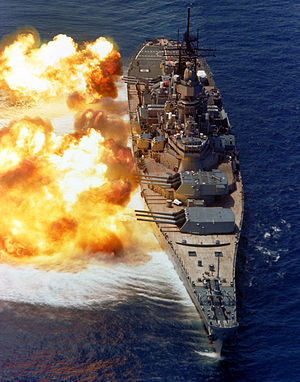
Back Линейни кораби тип „Айова“ Bulgarian Třída Iowa Czech Iowa-klassen Danish Iowa-Klasse German Θωρηκτό κλάσης Iowa Greek Clase Iowa Spanish نبردناو کلاس آیووا Persian Iowa-luokka Finnish Classe Iowa French אוניות המערכה מסדרת איווה HE
 USS Iowa (BB-61) fires a full broadside on 15 August 1984 during a firepower demonstration after her recommissioning
| |
| Class overview | |
|---|---|
| Name | Iowa-class battleship |
| Builders |
|
| Operators | |
| Preceded by | South Dakota class |
| Succeeded by | Montana class (planned) |
| Cost | US$100 million per ship |
| Built | 1940–1944 |
| In commission |
|
| Planned | 6 |
| Completed | 4 |
| Cancelled | 2 |
| Retired | 4 |
| Preserved | 4 |
| General characteristics | |
| Type | Battleship |
| Displacement | |
| Length | |
| Beam | 108 ft 2 in (32.97 m) |
| Draft |
|
| Installed power |
|
| Propulsion | 4 × screws; 4 × geared steam turbines |
| Speed | 33 knots (61.1 km/h; 38.0 mph) (up to 35.2 knots (65.2 km/h; 40.5 mph) at light load) |
| Range | 14,890 nmi (27,580 km; 17,140 mi) at 15 knots (28 km/h; 17 mph) |
| Complement |
|
| Sensors and processing systems |
|
| Electronic warfare & decoys |
|
| Armament |
|
| Armor | |
| Aircraft carried |
|
| Aviation facilities |
|
The Iowa class was a class of six fast battleships ordered by the United States Navy in 1939 and 1940. They were initially intended to intercept fast capital ships such as the Japanese Kongō class and serve as the "fast wing" of the U.S. battle line.[3][4] The Iowa class was designed to meet the Second London Naval Treaty's "escalator clause" limit of 45,000-long-ton (45,700 t) standard displacement. Beginning in August 1942, four vessels, Iowa, New Jersey, Missouri, and Wisconsin, were completed; two more, Illinois and Kentucky, were laid down but canceled in 1945 and 1958, respectively, before completion, and both hulls were scrapped in 1958–1959.
The four Iowa-class ships were the last battleships commissioned in the U.S. Navy. All older U.S. battleships were decommissioned by 1947 and stricken from the Naval Vessel Register (NVR) by 1963. Between the mid-1940s and the early 1990s, the Iowa-class battleships fought in four major U.S. wars. In the Pacific Theater of World War II, they served primarily as fast escorts for Essex-class aircraft carriers of the Fast Carrier Task Force and also shelled Japanese positions. During the Korean War, the battleships provided naval gunfire support (NGFS) for United Nations forces, and in 1968, New Jersey shelled Viet Cong and Vietnam People's Army forces in the Vietnam War. All four were reactivated and modernized at the direction of the United States Congress in 1981, and armed with missiles during the 1980s, as part of the 600-ship Navy initiative. During Operation Desert Storm in 1991, Missouri and Wisconsin fired missiles and 16-inch (406 mm) guns at Iraqi targets.
Costly to maintain, the battleships were decommissioned during the post-Cold War drawdown in the early 1990s. All four were initially removed from the Naval Vessel Register, but the United States Congress compelled the Navy to reinstate two of them on the grounds that existing shore bombardment capability would be inadequate for amphibious operations. This resulted in a lengthy debate over whether battleships should have a role in the modern navy. Ultimately, all four ships were stricken from the Naval Vessel Register and released for donation to non-profit organizations. With the transfer of Iowa in 2012, all four are museum ships part of non-profit maritime museums across the US.
- ^ Hyperwar: BB-61 USS Iowa Retrieved 1/7/23
- ^ a b Helvig 2002, p. 2
- ^ Hough 1964, pp. 214–216.
- ^ Sumrall 1988, p. 41.